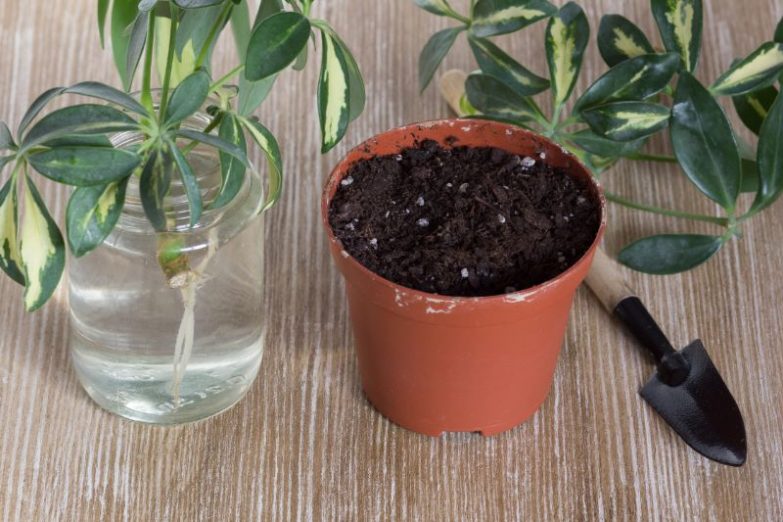The Schefflera arboricola, commonly known as the Umbrella Plant or Dwarf Schefflera, is an exotic-looking tropical plant with lots of personality and presence. These popular houseplants look great as single centerpieces or when massed together – you can’t have too many. In this article, we’ll outline the steps for successful Umbrella Plant propagation.
Umbrella Plant propagation is best done by growing stem cuttings in soil or water. They can also be propagated from seed or by air layering, but these have limitations. Successful propagation requires the right stem material and the correct temperature, soil moisture, humidity, and light.
Note: Keep cuttings and other Umbrella Plant material away from pets and children. Those little scraps can be tempting, but they’re poisonous!
If you’d like to learn how to propagate and grow all kinds of beautiful houseplants that thrive year after year, check out my book, “Houseplants Made Easy”.
Methods Of Propagating Umbrella Plants
Though they aren’t the easiest plants to grow from stem cuttings, this is the most common and practical method of Umbrella Plant propagation.
Dwarf Scheffleras have a single-stemmed growth pattern, so you can’t divide them; seeds require reliable sourcing and take longer to grow.
Air layering a Schefflera is straightforward, but it only reproduces a single new specimen at a time.
Why Propagate An Umbrella Plant?
Propagation is a fantastic way to increase your collection of Dwarf Scheffleras:
- It’s an efficient use of stem cuttings leftover from pruning.
- You can give baby Scheffleras away as gifts!
- If you have an Umbrella Plant you especially love, stem cuttings make exact clones.
When To Propagate An Umbrella Plant
The best time to take a stem cutting is in the spring or early summer. This gives your cutting time to root and establish itself during the warm season, and makes it easier for the parent plant to recover.
Theoretically, the timing isn’t so important with a houseplant that’s kept indoors year-round, but keep in mind it’s always a challenge to fight Mother Nature.
How To Propagate An Umbrella Plant
Whichever method you choose for propagation, make sure the plant is pest- and disease-free. Fertilize and make other changes well ahead of the big day so the plant has recovered from any stress.
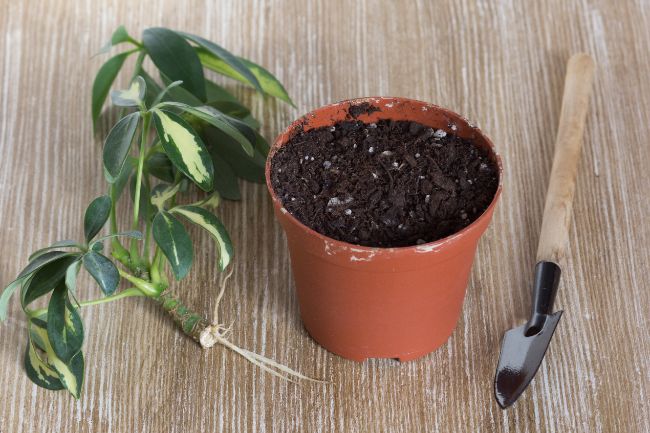
Stem Cuttings
Scheffleras aren’t the easiest plant to propagate through stem cuttings, but you can succeed with diligent attention.
Part of the large stem and a growth node must be included in the cutting. It’s possible, academically speaking, to slowly coax a leaf cutting into rooting, but it’s doubtful whether it can develop into a normal plant.
Here are the steps for Umbrella Plant propagation by stem cuttings:
1. Prepare the planting soil: dampen it thoroughly and mix with your hands until there are no dry spots. A standard houseplant potting mix with some added vermiculite makes a great rooting mix.
2. Use a sharp instrument that cuts cleanly. Scissors tend to crush the stem … a propagation or grafting knife is best; bypass pruners also work well. Sterilize your tool with isopropyl (rubbing) alcohol to avoid spreading pathogens to the young hopefuls.
3. Cut a four- to six-inch section from the stem just above a leaf node, preferably at the tip. The stem size should be at least the diameter of a pencil. Make a straight cut to speed callusing and minimize the potential area of pathogen invasion.
4. Trim off the bottom leaves; make sure to leaves at least one complete leaf set.
Note: Trimming will encourage branching from the node below the cut, so plan your pruning strategy accordingly.
5. If you aren’t immediately planting the cutting, wrap it in a damp paper towel to prevent moisture loss. Don’t let the cutting dry out.
6. Here are three basic ways to stimulate roots on your cutting:
- Poke a hole in the soil surface, place the cutting’s end into the mix, and firm the soil around it. Optionally, dip the end in rooting hormone to help stimulate root growth.
- Place the cutting in clean water until roots appear.
- Wrap the end in a paper towel and secure it with a rubber band. Remember to keep the paper damp!
7. Consider these optional steps:
- Cut the remaining leaves on your cutting in half, horizontally, to reduce moisture lost through transpiration. Since a cutting has no roots, the stem has minimal ability to supply the leaf with water.
- A horticultural heat mat underneath the cutting tray may encourage faster rooting.
8. Water lightly to seal the soil around the stem. Ensure the mix stays slightly moist: it’s critical that the medium isn’t soggy or too dry.
9. Give the cutting moderate indirect light but no direct sun. Lower light levels reduce transpiration and helps to focus the plant’s energy on root growth.
10. High humidity is important to help the cuttings grow. It minimizes water loss through the leaves and increases turgidity, which enables the plant’s systems to work properly.
The easiest way to optimize humidity is to raise the cuttings in a special tray with a clear plastic top. You can also place clear plastic over the plants to form a tent: keep the plastic from touching the leaves with a supporting structure made of a few pieces of wood or a reshaped wire hanger placed around the rim.
Remove the plastic covering daily to air the cuttings out.
11. Remove dead or decaying cuttings.
12. The cutting should start to sprout roots in about a month. The plant is ready to transplant when you see new growth on top. Don’t use a pot that’s too large – if the new plant is swimming in empty soil, it will be hard to properly regulate the medium’s moisture.
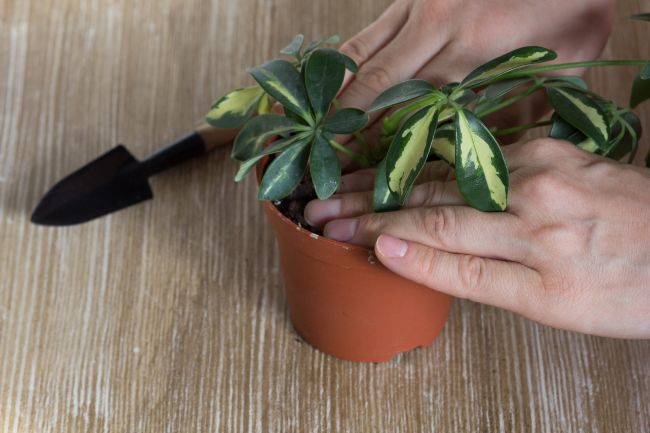
Growing From Seed
It takes longer to grow full-sized Umbrella Plants from seed, but it can be done. The challenge is to find fresh seeds from quality stock: only buy seeds from a reputable source.
Here are the steps:
- Prepare a germination tray using light potting soil.
- To increase the germination rate, soak the seeds in hot water of 140ºF (60ºC) for 12 hours before sowing.
- Plant each medium-sized seed to a depth twice its size.
- Water lightly; keep the soil moist but not wet.
- Maintain temperatures between 75ºF (24ºC) and 86ºF (º30C).
- Place the container in bright, indirect light and away from direct sun.
- Germination usually takes from two to three months.
- Transplant into individual pots once seedlings reach from one to two inches high.
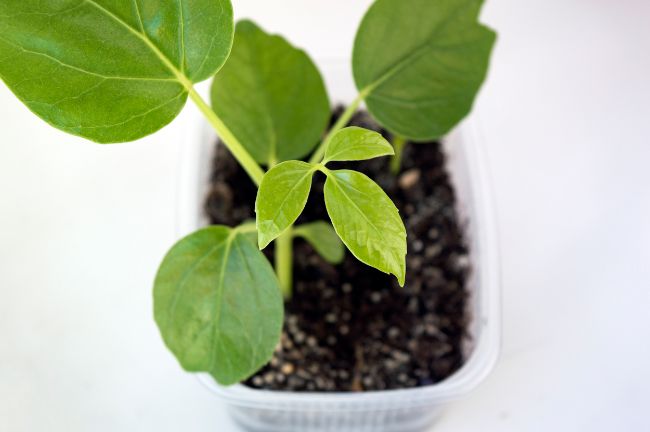
Air Layering
You can indeed propagate a Dwarf Schefflera using standard air layering. It’s a bit of effort for just one new plant, but it can be a reliable method if you’re having trouble with stem cuttings.
- Locate an open spot on the stem with leaves both above and below.
- Remove the plant’s outer layer in a ring about one inch wide around the stem, or cut about halfway through the stem at an angle.
- Wrap the area in damp sphagnum moss, making a clump about the size of a baseball and covering the wound completely.
- Cover the moss with plastic wrap and secure each end with tape to make the wound airtight.
- In one to two months, roots should appear inside the plastic. Clip the stem below the moss wrapping and plant the newly rooted portion in its own container.
How Big Should The Parent Plant Be?
Stem cuttings can be trimmed from any healthy plant. Just be sure to leave enough foliage that the plant can make a comeback.
You probably won’t notice a difference in a sizeable plant that only has a few cuttings taken from it. A healthy plant will regrow the “damage” quickly.
How To Care For Umbrella Plants After Propagation
Schefflera cuttings benefit from tenting that creates high humidity, but you can dispense with the covering once the plant is established. Though humidity is preferred, mature Scheffleras can adapt to less than high-humidity conditions.
Once a root system has developed, transplant the cutting into an individual pot. Prune the top shoots to encourage branching.
Scheffleras need bright, indirect light and loose, fertile soil. They require warm temperatures above 60ºF (16ºC). They can’t stand wet feet, so let the top few inches dry out before giving them a thorough rewatering – Yellow leaves are a common indication of overwatering but it can also be due to a number of other causes. Umbrella Plants tend to drop leaves when chronically underwatered;
The Umbrella Plant is a rather heavy feeder, but be gentle with new plants. Dilute the fertilizer to half the label’s recommendation. Light monthly applications of fertilizer during the growing season is generally sufficient, even for mature plants. Extra nutrients won’t help the young plant grow faster and can damage the tender roots.
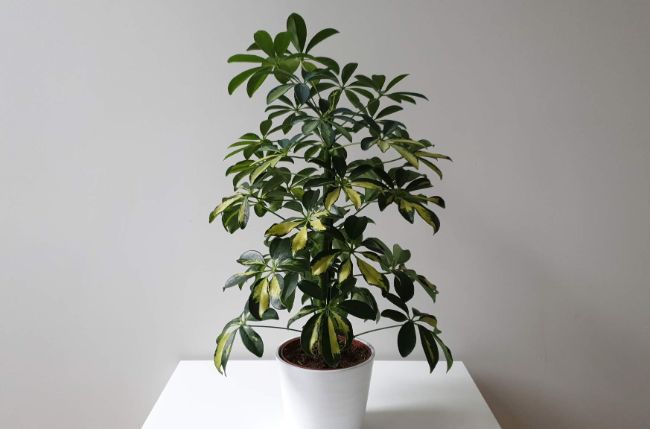
Are Any Umbrella Plant Varieties Easier To Propagate?
There are many forms of Schefflera, but the Dwarf version makes the most versatile and manageable houseplant. Variegated cultivars have yellow, gold, or white color patterns. They all propagate with the same degree of difficulty and use the same methods.
One caveat to propagating a variegated Schefflera through cuttings is to make sure there is some variegation on the leaves you select. An all-green cutting may grow into a plant without the variegation of its parent.
Don’t choose a cutting that is totally variegated, though: the new plant requires photosynthesis to produce energy, so it needs some chlorophyll-containing green areas.
Does Your Umbrella Plant Have To Be Healthy To Successfully Propagate?
As a rule, you only want to propagate a healthy plant. It can be tempting to try to propagate an ailing specimen as insurance against losing it, but it’s likely to be a futile exercise and won’t help the parent, either.
Stem cuttings share the same internal nutrients as its parent: deficiencies will therefore be present in the new plant. The cutting will have no roots, so problems are compounded and will show up quickly – and drastically.
Will Propagated Umbrella Plants Be Identical To The Mother Plant?
Stem cutting propagation uses asexual reproduction to create a clone of your plant – the new specimens will be genetically identical to the parent. (This goes for air layering too.)
Be aware that plants with identical genes won’t look the same if their growing conditions are different.
Seeds are formed by sexual reproduction and produce a plant with attributes from both parents. If you have a favorite Schefflera you want to multiply, stem cuttings are generally the way to go.
How Many Cuttings Can Be Taken From One Plant?
You can effectively dismantle a stock specimen into cuttings and leave it a denuded scrap, but if it’s a prized ornamental houseplant you’ll want to snip carefully.
This is why pruning time is an excellent opportunity to take cuttings: Prune to the shape you want and propagate the trimmed stems. Remember to do it at the start of growing season for best results.
How Long Do Stem Cuttings Take To Establish?
It takes several weeks for roots to sprout from a cutting and they start putting out top growth soon after. After two or possibly three months, most successful cuttings will be healthy new plants.
Common Umbrella Plant Propagation Problems
Monitor the soil carefully, because the main danger to your stem cuttings are fungal issues and pathogens related to moisture.
Perhaps unintuitively, tenting your cuttings to create high humidity helps reduce the danger of rot. The cuttings will be less prone to drying out and stay firmer and more healthy. Also, the soil stays more evenly moist without frequent watering.
Umbrella Plant propagation doesn’t have a 100% success rate, so don’t expect success with every cutting, and remove any that start to fail. Leaving dying, decaying plants in the group can allow pathogens to grow and invade other cuttings.

